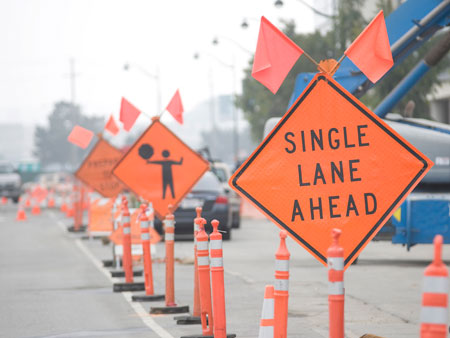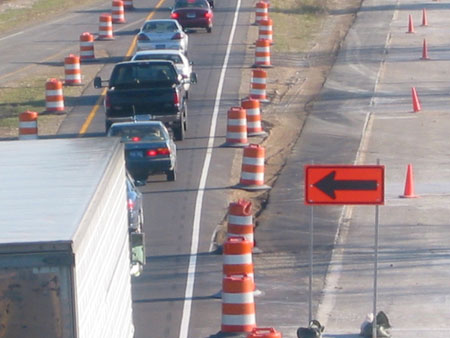U.S. Department of Transportation
Federal Highway Administration
1200 New Jersey Avenue, SE
Washington, DC 20590
202-366-4000
Focus
| Accelerating Infrastructure Innovations |
Publication Number: FHWA-HRT-12-008
Date: November 2011
Printable Version (.pdf, 0.6 mb)
How do roadway work zones in your city or State impact travelers, residents, businesses, and the local workforce? Find out how to better quantify the effects of work zones with the Federal Highway Administration's (FHWA) A Primer on Work Zone Safety and Mobility Performance Measurement (Pub. No. FHWA-HOP-11-033).
"Work zone performance measures help agencies improve their understanding of how their decisions during planning, design, and construction affect work zone safety and mobility, and thus can help improve how they make decisions for future work zones," said Tracy Scriba of FHWA.
As the primer notes, "work zone performance measurement should be driven by agency and other stakeholder needs and priorities. One advantage of establishing work zone performance measures is that it focuses attention on what is considered important to the agency and stakeholders."
The primer describes three basic types of performance measures that are useful in quantifying work zone safety and mobility impact. Exposure measures examine the amount of time, roadway space, or vehicle travel that a work zone affects or requires. Examples of exposure measures include the number of vehicles passing through the work zone and the average length of a lane closure in terms of distance. Safety measures assess how crash risk has changed for the individual motorist or for the traveling public in general, relative to the levels before the work zone existed. Potential safety measures include the percentage change in the crash rate compared to the expected crash rate when a work zone is not there. Finally, mobility (traffic operations) measures describe how travel mobility has been affected for motorists or other types of travelers. Examples of mobility measures include travel time and the average traffic queue duration and length.
Other types of mobility measures currently being used by States include the average speed of vehicles traveling through work zones, the percentage of work zones meeting agency expectations for traffic flow, and feedback received from customer surveys. The Missouri Department of Transportation, for example, has used online surveys that allow motorists to rate work zones.
The various work zone performance measures selected for use should:
"The idea of implementing a work zone performance measurement program can seem daunting if an agency thinks it must measure all work zones all the time," commented Scriba. "Agencies can still gain useful information from strategically monitoring a set of key work zones or focusing their measurements on key times, such as phase changes."
The primer also looks at how to define the data sources, collection techniques, and calculation methods that will be used to compute work zone performance measures. Agencies must balance the data needs for performance measures with available resources to determine the best data source or methodology. Data sources, for example, may range from manual documentation of traffic queues to portable work zone intelligent transportation systems to point-to-point travel time measurement systems, such as automatic vehicle location technology. The primer discusses the advantages and disadvantages offered by these different sources.
For transportation departments just embarking on work zone performance measurement, the primer outlines key steps on how to make it happen in your agency. In addition to selecting performance measures and identifying data sources, important steps include identifying and engaging stakeholders, defining analysis requirements, and defining methods for disseminating results. For example, some agencies use "dashboard" displays of key measures on their Web sites, while others incorporate the results into an annual report.
A final step in the process is to review and refine measures as needed. Rather than a "one-and-done" activity, agencies should plan to revisit their work zone performance measurement program on a regular basis. "Changes in performance measurement needs, data sources, and knowledge and understanding of how to use the measures to improve agency operations will undoubtedly occur over time," said Scriba.
To download a copy of the primer or to view related materials on work zone performance measures, such as presentations and a recording from an October 2011 Webinar, visit www.ops.fhwa.dot.gov/wz/decision_support/performance-development.htm. For more information on work zone performance measurement, contact Tracy Scriba at FHWA, 202-366-0855 (email: tracy.scriba@dot.gov).

Work zone performance measures help agencies improve their understanding of how their decisions during planning, design, and construction affect work zone safety and mobility. Photo Credit: © www.iStockphoto.com/silvrshootr

Among the work zone performance measures that agencies can use are those that examine exposure, safety, and mobility.